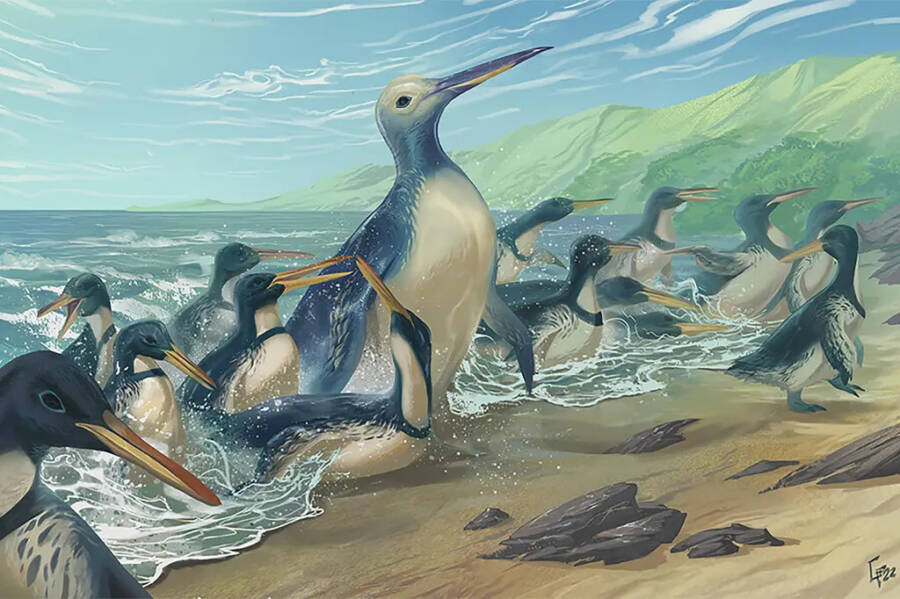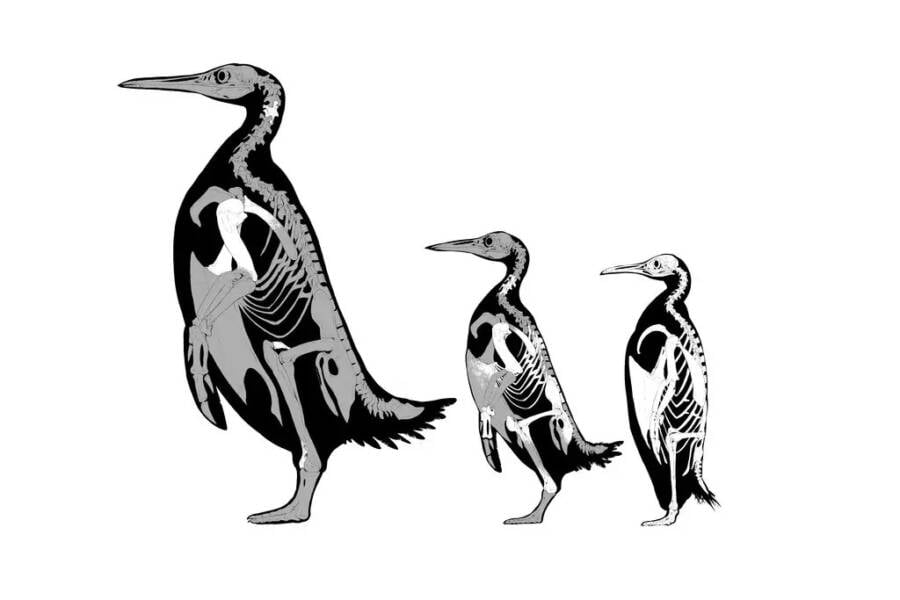In 2017, paleontologists in New Zealand discovered fossils belonging to the ancient species Kumimanu fordycei, now believed to be the largest penguin in history.

Simone Giovanardi/Bruce MuseumReconstruction of Kumimanu fordycei, the biggest penguin in history, on an ancient New Zealand beach with another ancient penguin species, the Petradyptes stonehousei.
Paleontologists know that the cute and lovable penguins we recognize today were once massive beasts capable of reaching heights and weights that would put even bodybuilders to shame — but they recently identified likely the largest in history.
In 2017, researchers uncovered fossils from the ancient Kumimanu fordycei, a nearly six-foot, 300-pound penguin that prowled the waters off the coast of New Zealand.
Alan Tennyson, a paleontologist at Museum of New Zealand Te Papa Tongarewa, discovered the fossils at a New Zealand beach known for its 57-million-year-old boulders. According to the New York Times, the tide gradually weathered the boulders, causing them to crack open and reveal bits of fossilized bone inside.
The fossils immediately intrigued researchers, and they collected samples for testing. One fossil, an upper arm bone measuring more than nine-and-a-half inches long, was nearly double the size of one from an emperor penguin, the largest penguin alive today. And researchers quickly realized that they were dealing with the fossils of perhaps the largest penguin to ever walk the earth.
After going through the fossils and organizing them by specimen, Dr. Tennyson and his team identified eight different specimens, one of clearly the biggest. The team created a name for the new-found massive penguin: Kumimanu fordycei, a combination of Maori words meaning “monster” and “bird.” Researchers were also able to identify another new species of massive penguin called Petradyptes stonehousei, or “rock diver.”

Simone Giovanardi/Bruce MuseumSkeleton comparisons of the Kumimanu, Petradyptes, and emperor penguins.
According to Dr. Tennyson and his team’s published study, a 3D rendering of the Kumimanu fordycei‘s skeleton estimated that the bird would have weighed roughly 340 pounds.
The height of the bird, however, was harder to pinpoint. According to Daniel Ksepka, a paleontologist at the Bruce Museum in Connecticut and co-author of the published study, the incomplete fossils of the Kumimanu fordycei make it difficult to estimate its full size. Ksepka guesses that the “monster bird” may have stood between five and six feet.
Previously, the record-holder for largest penguin belonged to the Antarctic Palaeeudyptes klekowskii. According to LiveScience, it weighed 256 pounds and stood at roughly seven feet tall.
While not breaking records for height specifically, the Kumimanu fordycei fossils may prove invaluable for researchers, especially given the fossils’ location.
When asked by LiveScience how the fossils wound up in New Zealand rather than a more obvious location like Antarctica where researchers have previously found impressive ancient penguin fossils, Ksepka replied: “New Zealand is (and has been) a great place to be a penguin. There are good feeding grounds offshore for marine birds, and there were no land mammals other than bats in New Zealand before humans arrived, which makes for safer nesting areas.”
According to LiveScience, the Kumimanu fordycei and the Petradyptes stonehousei may be two of the oldest ancient penguins, and their remains may provide researchers with a better understanding of how ancient penguins evolved across the globe.
Researchers began studying ancient penguins’ evolution by examining their flipper bones for signs of flight. Both the Kumimanu fordycei and Petradyptes stonehousei had “relatively primitive flipper bones,” Ksepka saod. “In many ways [they] resemble those of birds that can both fly through the air and propel themselves underwater with their wings, such as auks and puffins.”
This finding is important given that penguins lost the ability to fly sixty million years ago, shortly before the Kumimanu fordycei roamed New Zealand waters. The condition of the Kumimanu fordycei and the Petradyptes stonehousei’s wings may provide researchers with a better timeline of penguins’ evolution to complete flight inability and the development of more reliable flippers.

Bruce Museum Daniel Ksepka standing next to a life-size cutout of the Kumimanu fordycei.
According to Australian Geographic, giant ancient penguins like the Kumimanu fordycei existed until roughly 27 million years ago. Researchers are still unsure why they went extinct, but competition and lack of resources may be reasons for the birds’ disappearance.
While humans may not be able to view these monster penguins in person, museums around the world are exploring the history and evolution of these creatures.
And “the size of Kumimanu fordcyei doesn’t necessarily mean there wasn’t an even larger species that is yet to be discovered,” Ksepka hinted. “The sky’s the limit.”
After learning the world’s biggest ancient penguin, uncover 11 of the world’s most unbelievable prehistoric animals. Then, read about 10 terrifying prehistoric animals that weren’t dinosaurs.





